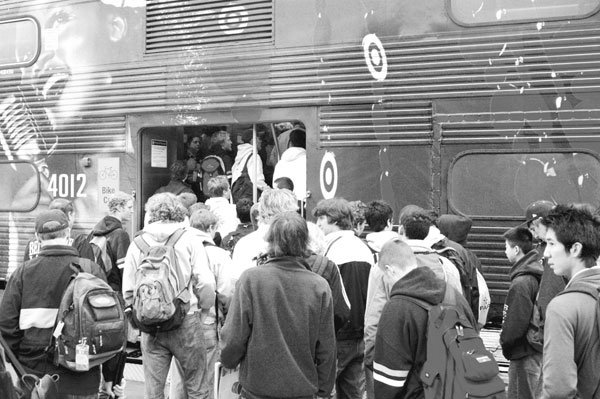Gilroy
– Mentioned in works by Jack London and Jack Kerouac, the
College Park rail station in San Jose occupies a small place in
literary history. But neither of those writers ever knew about
Caltrain, and trains don’t run on nostalgia.
Gilroy – Mentioned in works by Jack London and Jack Kerouac, the College Park rail station in San Jose occupies a small place in literary history. But neither of those writers ever knew about Caltrain, and trains don’t run on nostalgia.
More than 100 years after it opened, the College Park station is about to close because it doesn’t figure in to Caltrain’s plans to rescue itself from severe budget shortages. Caltrain staffers have concluded that express trains are the way back to fiscal stability and College Park is in the way.
The station is one of four that Caltrain has threatened with extinction, but the only one located across the street from Bellarmine College Preparatory school and a large group of administrators, parents and students determined to keep the station open. College Park might not have the most riders, they say, but it does exactly what public transit is meant to do – serve a community and keep people out of their cars.
“It’s a matter of what Santa Clara County is trying to accomplish and how Caltrain fits into that,” said Jan Johnson, a Gilroy mother of two Bellarmine students who commute on Caltrain. “If you really want transit that serves a community, there’s no better example than Bellarmine. The impact on the neighborhood if you take the train away is going to be huge.”
Estimates on the number of riders who regularly disembark at College Park range from 200 to 300, almost all of whom are Bellarmine students and staff. According to Bellarmine controller Thomas Gorndt, about 100 of those riders come from South County.
“Bellarmine has been there for 80 years and the property was purchased because of access to the railroad,” Gorndt said.
Parents say that without Caltrain many South County students could not attend Bellarmine. They say the system’s low cost helps lower-income scholarship students get to school, teaches students to respect the environment and is the only safe and reliable way for students to make to it school on time.
Norma Luvergnani’s sophomore son, Diego, takes the train most days from South County to Bellarmine. Luvergnani said that having that option played a huge role in sending her son to the school.
“What was important about Bellarmine was not just a good education, but affordable transportation,” she said. “Many kids who can not afford to go to Bellarmine can get financial aid, but if you take away the affordable transportation, people will not even apply.”
And for students, the 53-minute trek from Gilroy to College Park is a chance to study, sleep, hang out with their friends and look at girls.
“When I drive, I can’t relax on the way to school. Being in traffic is just stressful in itself,” Gilroy junior Andrew Gutierrez said. “If I have a big test, I can study on the train.”
Gutierrez’s freshman brother Stephen said his commute is the one time during his day that he can really socialize with his classmates. “It’s important to be with your friends,” he said.
But as the period for the public to comment on a series of proposed changes to Caltrain service – including closing four stations, running fewer trains to Gilroy and raising fares 17.5 percent – Caltrain staff was unmoved by Bellarmine’s arguments.
Caltrain Spokeswoman Jayme Kunz said she agrees that serving communities is the ideal of transit systems, but College Park can simply not attract the number of riders Caltrain needs to balance its budget.
“We want to serve the greatest number of people possible,” Kunz said. “This is a system-wide issue. We are trying to save Caltrain. The only way we’re going to do that is offer faster service.”
In addition to the fare increase, the key to Caltrain’s plan is to offer several more of the profitable “baby bullet” commuter trains to San Francisco and replace some local service with express trains. Caltrain staff believes doing so will bring in an additional $2.5 million in annual revenue. The fare increase will add $3.4 million to Caltrain coffers. The agency is scrambling to close a budget gap of at least $13.6 million for the fiscal year beginning July 1.
Kunz said the College Park station interferes with express trains because northbound passengers must cross the southbound tracks to get on. That forces other trains to idle outside the station. Kunz said the agency can’t afford the $7 million it would take to refurbish the station and make safety improvements.
Whether or not the station closes or is able to maintain enough service for Bellarmine students is ultimately up to the agency’s board of directors, which comprises three representatives from San Francisco, San Mateo and Santa Clara counties. The station has at least two supporters. Both Santa Clara County Supervisor Don Gage and San Jose City Councilman Ken Yeager, whose district includes Bellarmine, have voiced strong support for the College Park station.
“I don’t know if we’ll be able to keep it open,” Yeager said Thursday. “I think all three members from Santa Clara County are in support of keeping the station open, but I don’t have a sense of the other six. I’m absolutely in favor. I think the ridership warrants it, and I think there are better ways to save money than by closing stations.”
Kunz suggested that if the station closes, Bellarmine students can easily ride the train to San Jose Diridon Station and catch a bus to Bellarmine, but parents and students say that trip takes too long and isn’t as safe as Caltrain. The only good way to get to school, they say, is a Caltrain trip that ends in College Park.
“We want to fight this battle because in the future other young kids will need this opportunity,” Luvergnani said. “We’re doing this for the next generation.”
In addition to College Park, Caltrain is considering closing Atherton, Broadway in Burlingame and Paul Avenue in San Francisco. A final decision on all changes is expected on April 22.
Who to contact
To comment on any of Caltrain’s proposed changes,
e-mail the board of directors:
Caltrain ch*****@******in.com
Jim Hartnett jh*******@*********ty.org
John Mclemore jl********@*ol.com
Ken Yeager di*******@*******ca.gov
Don Gage do******@*******************ca.us
Sophie Maxwell so************@***ov.org
Michael Burns mi***********@******ca.us
Jose Cisneros tr********************@***ov.org













